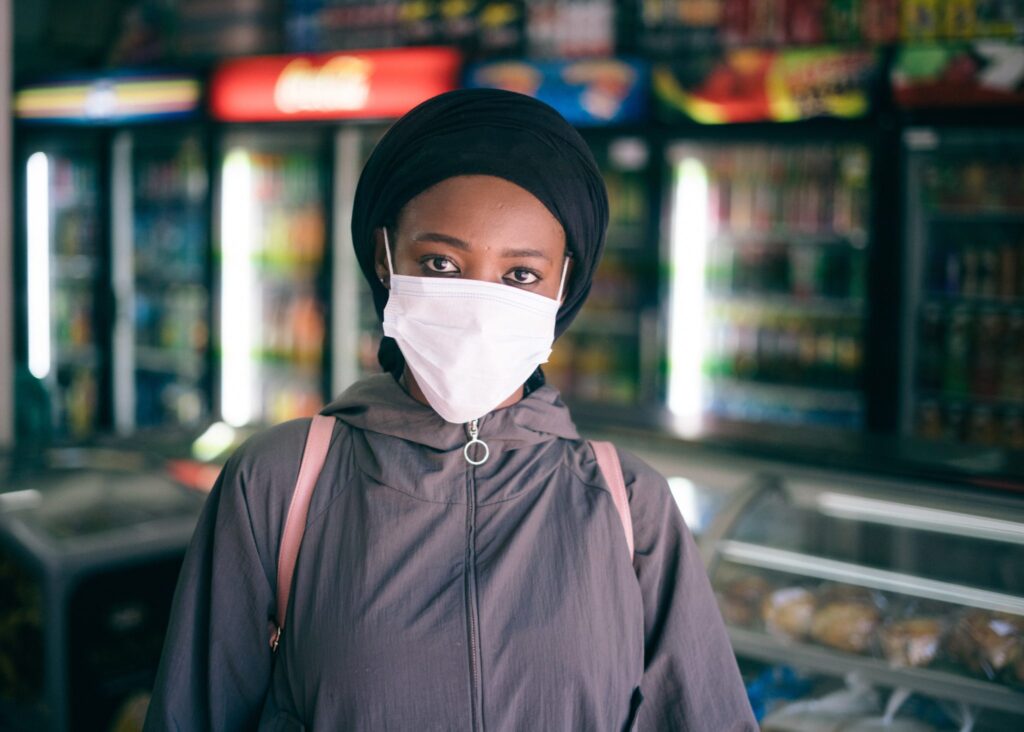COVID-19 & Health Equity, High School Science
What can we learn from the spread of the COVID-19 virus to protect our communities?

Unit Summary
This unit is designed to support students in understanding the COVID-19 pandemic, transmission of the COVID-19 virus, and the impacts of the pandemic on communities, especially communities of color. Specific learning targets are listed at the beginning of each lesson and highlight a core idea for the lesson, the science and engineering practice students will engage in, and the crosscutting concept students will use in the lesson. There are four broad areas of learning goals targeted in this unit:
- virus transmission between people and communities,
- mitigation strategies and using probabilities to explain how we can lower the chance of transmitting the virus between people and across communities,
- understanding disproportionate impacts on communities and the policies and practices that lead to those impacts, and finally,
- development of two social emotional competencies--self awareness and social awareness.

Simulations
Unit Examples
Additional Unit Information
Next Generation Science Standards Addressed in this Unit
Next Generation Science Standards: Science and Engineering Practices

Students build toward these elements for high school:
- Practice 2: Developing and Using Models.
-
- Develop, revise, and/or use a model based on evidence to illustrate and/or predict the relationships between systems or between components of a system.
- Practice 4: Analyzing and Interpreting Data.
-
- Apply concepts of statistics and probability (including determining function fits to data, slope, intercept, and correlation coefficient for linear fits) to scientific and engineering questions and problems, using digital tools when feasible.
- Practice 6: Constructing Explanations and Designing Solutions.
-
- Apply scientific ideas, principles, and/or evidence to provide an explanation of phenomena and solve design problems, taking into account possible unanticipated effects.
- Practice 8: Obtaining, Evaluating, and Communicating Information
-
- Compare, integrate and evaluate sources of information presented in different media or formats (e.g., visually, quantitatively) as well as in words in order to address a scientific question or solve a problem.
Next Generation Science Standards: Crosscutting Concepts

Students build toward these elements for high school:
- Crosscutting Concept 1: Patterns.
- Different patterns may be observed at each of the scales at which a system is studied and can provide evidence for causality in explanations of phenomena.
- Crosscutting Concept 2: Cause and Effect.
- Cause and effect relationships can be suggested and predicted for complex natural and human designed systems by examining what is known about smaller scale mechanisms within the system.
- Changes in systems may have various causes that may not have equal effects.
- Crosscutting Concept 3: Scale, Proportion, and Quantity.
- The significance of a phenomenon is dependent on the scale, proportion, and quantity at which it occurs.
Collaborative for Academic, Social, & Emotional Learning (CASEL) Core Competencies

- Self-awareness: The ability to accurately recognize one’s own emotions, thoughts, and values and how they influence behavior.
- Identifying emotions
- Self-efficacy
- Social Awareness: The ability to take the perspective of and empathize with others, including those from diverse backgrounds and cultures. The ability to understand social and ethical norms for behavior and to recognize family, school, and community resources and supports.
- Perspective-taking
- Empathy
Unit Acknowledgements
Unit Development Team

- Katie Van Horne, Unit Lead, Concolor Research
- Lindsey Mohan, Unit Storyline and Reviewer, BSCS Science Learning
- Dawn Novak, Writer and Reviewer, BSCS Science Learning
- Holly Hereau, Writer and Reviewer, BSCS Science Learning
- Nicole Vick, Writer and Reviewer, BSCS Science Learning
- Michael Novak, Writer, Northwestern University
- Ally Orwig, Writer, Denver Public Schools
- Tyler Scaletta, Writer, Chicago Public Schools
- Dan Voss, Writer, Dallas Center-Grimes High School
- Joy Barnes-Johnson, Writer, Morgan State University
- Arash Jamshidi, Unit Storyline, University of California, Berkeley
- Rebecca Kaplan, Unit Storyline and SEL Learning, Summit School District
- Audrey Mohan, Unit Storyline and Reviewer, BSCS Science Learning
Project Leadership

- Lindsey Mohan, Division Director, Instructional Materials Development, BSCS Science Learning
- Danny Edelson, Executive Director, BSCS Science Learning
Production Team

- Renée DeVaul, Copyeditor, BSCS Science Learning
- Stacey Luce, Copyeditor, BCSC Science Learning
- Kate Herman, Copyeditor, Independent Contractor
- Becca Greer, Project Coordinator, BSCS Science Learning
- Chris Moraine, Multimedia Graphic Designer, BSCS Science Learning
- Kate Chambers, Multimedia Graphic Designer, BSCS Science Learning
- Sean O’Connor, GIS Mapping, BSCS Science Learning
- Gretchen Peterson, GIS Mapping, PetersonGIS
Contributing Experts

- Dr. Doriane Miller, The University of Chicago Medicine
- Carlos Nelson, Greater Auburn Gresham Development Corporation
- Norma Sanders, Greater Auburn Gresham Development Corporation
- Haya Muhammad, Greater Auburn Gresham Development Corporation
The development team consulted with the following experts to inform their development of the unit.
- Larry Gold, SomaLogic
- Ashley St. John, Duke-NUS Medical School
- Maria Sundaram, Emory University
- Tiffany Clark, Seattle, WA
- Claudia Ludwig, Institute for Systems Biology
- Becky Howsmon, Institute for Systems Biology
The development team wants to thank the following experts who reviewed parts of the unit.
- Marceline DuBose, Equity Literacy Institute
- Brian Donovan, BSCS Science Learning
- Monica Weindling, BSCS Science Learning
- Zoë Buck Bracey, BSCS Science Learning
Field Test Team

- Cari Herrmann Abell, Senior Research Scientist, BSCS Science Learning
- Joseph Hardcastle, Senior Research Associate, BSCS Science Learning
- Lisa Carey, Senior Research Associate, BSCS Science Learning
Unit standards
This unit builds toward the following standards:
- Next Generation Science Standards: Science and Engineering Practices
- Next Generation Science Standards: Crosscutting Concepts
- Collaborative for Academic, Social, & Emotional Learning (CASEL) Core Competencies





